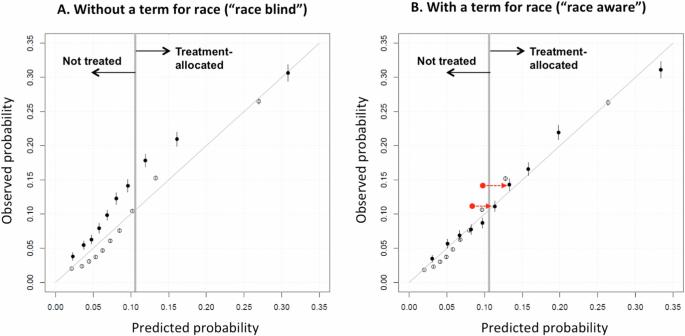Guidance for unbiased predictive information for healthcare decision-making and equity (GUIDE): considerations when race may be a prognostic factor
IF 12.4
1区 医学
Q1 HEALTH CARE SCIENCES & SERVICES
引用次数: 0
Abstract
Clinical prediction models (CPMs) are tools that compute the risk of an outcome given a set of patient characteristics and are routinely used to inform patients, guide treatment decision-making, and resource allocation. Although much hope has been placed on CPMs to mitigate human biases, CPMs may potentially contribute to racial disparities in decision-making and resource allocation. While some policymakers, professional organizations, and scholars have called for eliminating race as a variable from CPMs, others raise concerns that excluding race may exacerbate healthcare disparities and this controversy remains unresolved. The Guidance for Unbiased predictive Information for healthcare Decision-making and Equity (GUIDE) provides expert guidelines for model developers and health system administrators on the transparent use of race in CPMs and mitigation of algorithmic bias across contexts developed through a 5-round, modified Delphi process from a diverse 14-person technical expert panel (TEP). Deliberations affirmed that race is a social construct and that the goals of prediction are distinct from those of causal inference, and emphasized: the importance of decisional context (e.g., shared decision-making versus healthcare rationing); the conflicting nature of different anti-discrimination principles (e.g., anticlassification versus antisubordination principles); and the importance of identifying and balancing trade-offs in achieving equity-related goals with race-aware versus race-unaware CPMs for conditions where racial identity is prognostically informative. The GUIDE, comprising 31 key items in the development and use of CPMs in healthcare, outlines foundational principles, distinguishes between bias and fairness, and offers guidance for examining subgroup invalidity and using race as a variable in CPMs. This GUIDE presents a living document that supports appraisal and reporting of bias in CPMs to support best practice in CPM development and use.

医疗决策和公平的无偏见预测信息指南(GUIDE):种族可能成为预后因素时的考虑因素
临床预测模型(CPM)是根据一组患者特征计算结果风险的工具,通常用于为患者提供信息、指导治疗决策和资源分配。尽管人们对临床预测模型寄予厚望,希望它能减轻人类的偏见,但临床预测模型可能会在决策和资源分配方面造成种族差异。一些政策制定者、专业组织和学者呼吁将种族作为一个变量从 CPM 中剔除,而另一些人则担心将种族排除在外可能会加剧医疗差距,这一争议至今仍未解决。用于医疗决策和公平的无偏见预测信息指南》(GUIDE)为模型开发者和医疗系统管理者提供了专家指南,指导如何在 CPM 中透明地使用种族,以及如何在不同情况下减少算法偏差,该指南是由一个 14 人技术专家小组(TEP)通过 5 轮修改后的德尔菲流程制定的。讨论肯定了种族是一种社会建构,预测的目标与因果推断的目标不同,并强调了:决策背景(如共同决策与医疗保健配给)的重要性;不同反歧视原则(如反分类原则与反从属原则)的冲突性;以及在种族身份具有预后信息的情况下,识别和平衡种族感知与种族非感知 CPM 在实现公平相关目标方面的权衡的重要性。本指南包括 31 个在医疗保健领域开发和使用 CPM 的关键项目,概述了基本原则,区分了偏见和公平,并为检查亚组无效性和在 CPM 中使用种族作为变量提供了指导。本指南提供了一份活文件,支持对 CPM 中的偏差进行评估和报告,以支持 CPM 开发和使用中的最佳实践。
本文章由计算机程序翻译,如有差异,请以英文原文为准。
求助全文
约1分钟内获得全文
求助全文
来源期刊

NPJ Digital Medicine
Multiple-
CiteScore
25.10
自引率
3.30%
发文量
170
审稿时长
15 weeks
期刊介绍:
npj Digital Medicine is an online open-access journal that focuses on publishing peer-reviewed research in the field of digital medicine. The journal covers various aspects of digital medicine, including the application and implementation of digital and mobile technologies in clinical settings, virtual healthcare, and the use of artificial intelligence and informatics.
The primary goal of the journal is to support innovation and the advancement of healthcare through the integration of new digital and mobile technologies. When determining if a manuscript is suitable for publication, the journal considers four important criteria: novelty, clinical relevance, scientific rigor, and digital innovation.
 求助内容:
求助内容: 应助结果提醒方式:
应助结果提醒方式:


